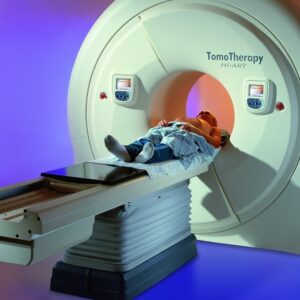Tomotherapy
Tomotherapy is an advanced form of radiation therapy that combines the principles of computed tomography (CT) imaging and intensity-modulated radiation therapy (IMRT) to deliver precise radiation treatment to cancer patients. Here’s a closer look at tomotherapy, its technology, and its applications.
Mechanism:Tomotherapy delivers highly focused radiation in a helical (spiral) fashion around the patient, similar to a CT scan.This approach enables constant adjustment and real-time imaging to ensure precise dose delivery.
Key Features of Tomotherapy
- Integrated Imaging:
- Tomotherapy uses CT imaging to provide detailed anatomical information about the tumor and surrounding tissues. This imaging helps radiation oncologists visualize the target area accurately, allowing for better treatment planning.
- Helical Delivery:
- The treatment is delivered in a helical (spiral) fashion, rotating around the patient. This allows for multiple beams of radiation to be delivered from different angles, which helps conform the radiation dose to the shape of the tumor while sparing healthy tissue as much as possible.
- Intensity Modulation:
- Tomotherapy employs IMRT techniques, which enable the modulation of radiation intensity. By varying the dose delivered from different angles, it can target complex tumor shapes and sizes more effectively.
- Real-Time Imaging:
- Some tomotherapy systems can perform real-time imaging during treatment, allowing for adjustments to be made if the patient’s position changes or if there are any variations in the target anatomy. This ensures that the radiation is delivered accurately to the intended target.
Components
CT Imaging: Integrated CT scanner provides 3D images of the tumor before each treatment session for accurate positioning.
Linear Accelerator: Delivers the therapeutic radiation beam.
Treatment Planning System: Sophisticated software plans treatment tailored specifically to each patient’s anatomy and tumor characteristics.
Applications of Tomotherapy
Can be used for various types of cancers including prostate, breast, lung, and head & neck cancers. Particularly beneficial for tumors located near sensitive structures or organs because it minimizes exposure to surrounding healthy tissues.
Tomotherapy is used to treat various types of cancers, including but not limited to:
- Head and neck cancers
- Prostate cancer
- Lung cancer
- Gynecological cancers (like cervical and uterine cancers)
- Central nervous system tumors
- Breast cancer
- Precision: Reduced risk of damage to adjacent organs/tissues. Helical delivery allows uniform dose distribution across complex shapes while sparing adjacent normal tissues.
- Reduced Side Effects: The ability to focus beams precisely reduces common side effects associated with conventional radiotherapy like skin irritation or damage**to nearby organs/tissues beyond target area!
- Real-time Imaging: The integrated CT scanner allows for daily verification of tumor location, ensuring that the radiation is delivered to the correct area. Daily imaging ensures that any changes in tumor size/position are accounted-for so adjustments can made accordingly immediately if needed during course-of-care!
- Adaptability: Can be adjusted based on patient position changes during treatment. If necessary; clinicians have option re-plan using updated imaging data reflecting anatomical changes over time such as weight loss/gain etc., enhancing efficacy even further without requiring additional scans/treatment interruptions**
- Shorter Treatment Times: Treatments can often be completed more quickly compared to traditional techniques.
- Availability & Cost Considerations*: Access limited mainly larger centers equipped specialized machinery hence logistical challenges may arise relate travel/accommodation expenses especially rural areas where facilities scarce/not available nearby home base location etc., cost implications could present financial burden despite potential benefits offered through use technology!
- Radiation Exposure Risks: As with all forms medical irradiation; there’s inherent risk developing secondary malignancies later life due cumulative effect doses received though generally outweighed by immediate need address primary concern effectively/proactively mitigate progression cancer itself initially among others
Conclusion
Tomotherapy represents a significant advancement in cancer treatment technology by integrating imaging with precise delivery methods—patients should discuss with their healthcare team regarding whether this option fits within their overall therapeutic strategy tailored accordingly based upon specific clinical scenarios presented!
If you have specific questions about oncology treatments, its management, or anything related, feel free to ask! We will be pleased to help you with our wide hospital & clinic network all over the Turkiye.

